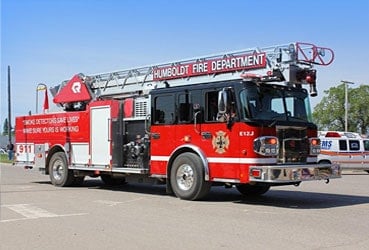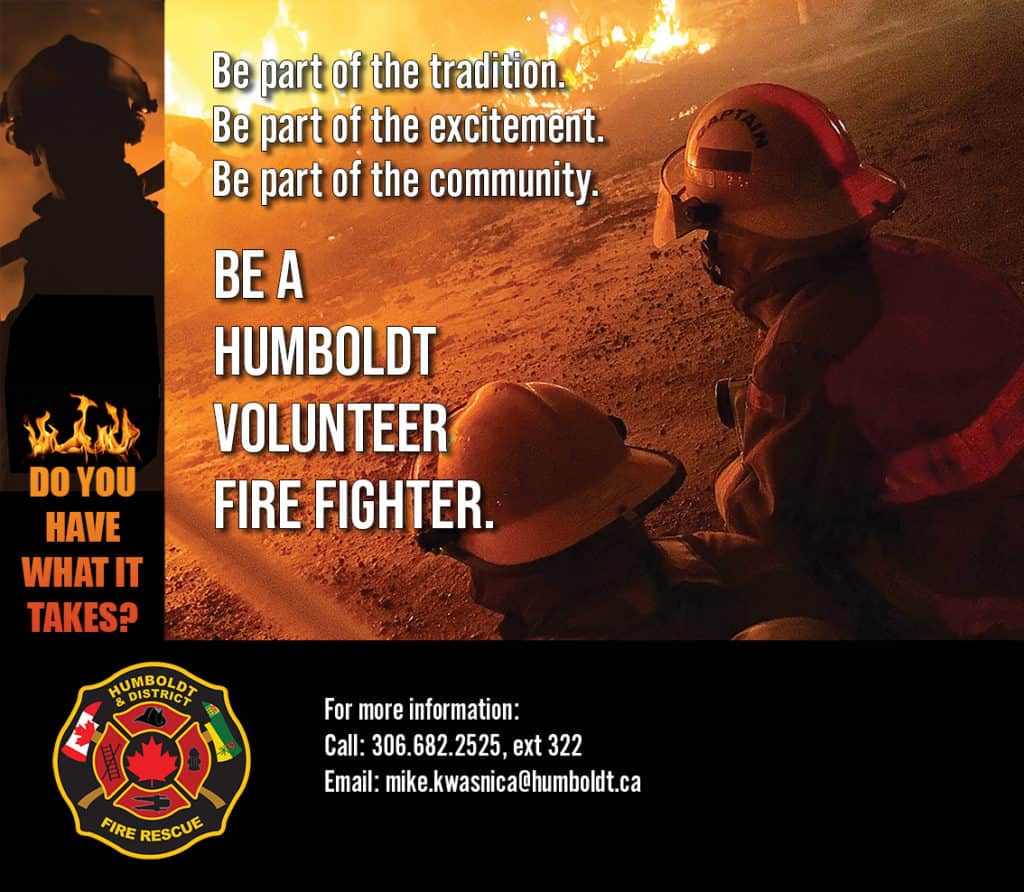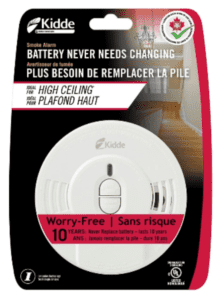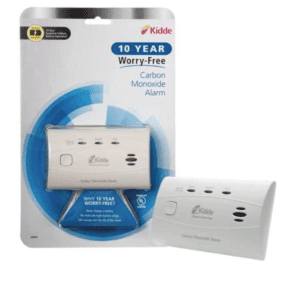Fire Department
The Humboldt Fire Department (HFD) is committed to serving the community and surrounding area through excellence in fire prevention, education, community protection as well as safety programs and services.
Under the direction of Fire Chief Mike Kwasnica and Deputy Fire Chief Darrell Wickenhauser, a volunteer force of over 25 members proudly protect Humboldt’s residents.



HFD’s primary services include:
- Delivering emergency fire services;
- Enforcing building bylaws and safety codes through inspections, training and education to individuals as well as businesses;
- Promoting fire prevention and safety education programs; and
- Supporting emergency and disaster management planning, preparedness and response.
HFD also assists the RCMP, Humboldt Ambulance Services and STARS Air Ambulance Services for Humboldt and area.
Become a Fire Volunteer
Interested in Becoming a Fire Volunteer?
Some of the rewards of being a volunteer fire fighter are that you will improve your skills in emergency response, gain invaluable teamwork experience, and most importantly, you will get a great sense of personal fulfilment knowing that you are helping to protect your community.
Becoming a fire volunteer is a big responsibility and can be very demanding. Please consider the following:
- Attending fire calls are very challenging, both mentally and physically.
- On-going training session are mandatory and require a personal commitment and some sacrifices to ensure you are educated and prepared.
- Fire volunteers are expected to participate in community awareness programs and services to help promote fire safety to
“Do you have what it takes?”
Interested applicants must fill out and submit the following forms or contact the HFD at (306) 682-2525 ext. 324 for more information.

Carbon Monoxide and Smoke Alarms - Requirements and Recommendations
On January 1, 2022, the Construction Codes Act and Building Code Regulations came into effect in Saskatchewan replacing the Uniform Building and Accessibility Standards Act and Regulations (UBAS Act and Regs), respectively. The Building Code Regulations has the following requirements that will come into force on July 1, 2022:

Every building that contains a residential occupancy is required to have smoke alarms installed inside each bedroom, in the bedroom corridor, and each storey without a bedroom. These smoke alarms are permitted to be battery operated. If the building was constructed before June 6, 1988, then the batteries used for the smoke alarms must be 10-year batteries (see photo for example of 10-year battery alarm).

Every building that contains a residential occupancy is required to have a carbon monoxide alarm installed inside each bedroom OR within 5 m (16’) of each bedroom door. These carbon monoxide alarms are permitted to be battery operated. If the building was constructed before October 1, 2009, then the batteries used for the carbon monoxide alarms must be 10-year batteries (see photo for example of 10-year battery alarm).

What does this mean for owners?
If your house/condo/duplex/etc. is missing smoke and/or carbon monoxide alarms in the locations listed above, then as the owner it is your responsibility to install the missing alarms.
Are carbon monoxide (“CO”) alarms installed and maintained in your home? If not, then you and everyone in your household could be at risk of CO poisoning. Carbon monoxide alarms inside your home provide an early warning of the presence of deadly carbon monoxide gas.
According to the National Fire Protection Association (NFPA) and the National Building Code, CO alarms should be installed and maintained in a central location outside each separate sleeping area, on every level of the home, and in other locations, as required by laws, codes, or standards. Install CO alarms that meet the current safety standards. CPSC recommends that consumers look for ULC or CSA listings on the packaging. Follow the manufacturer’s installation instructions. For the best protection, interconnect all CO alarms throughout the home. When one interconnected CO alarm sounds, they all sound.
Fire Chief Kwasnica says CO alarms can mean the difference between life and death. According to NFPA, fire department responses to non-fire CO incidents have increased over the past decade. Between 2006 and 2010, there was an average of 72,000 fire department responses due to carbon monoxide (without fire) per year. The vast majority, 94 percent, occur in homes. CDC reports that from 1999 to 2010, an average of 430 people were killed by unintentional non-fire related CO poisoning per year from consumer combustion appliances and motor vehicles.
Often called the invisible killer, CO is an odorless, colorless gas created when fuels burn incompletely. In the home, heating and cooking equipment that burn fuel can be sources of CO. Also, anything that has an engine, such as vehicles running in an attached garage, or portable generators running inside a home, shed, attached garage or too close to a home also can produce dangerous levels of CO. Burning charcoal in fireplaces or barbeque grills inside a home or in semi-enclosed areas can also result in lethal carbon monoxide levels.
The Humboldt Fire Department, NFPA, and the U.S. Consumer Product Safety Commission (CPSC) offer the following tips for making sure the CO alarms in your home are maintained and working properly:
- Install and maintain CO alarms in a central location outside each separate sleeping area, on every level of the home, and in other locations, as required by laws, codes, or standards.
- If you have combination smoke/carbon monoxide alarms, follow the directions for smoke alarm installation.
- Test CO alarms once a month, and replace them if they fail to respond correctly when tested.
- Replace the CO alarm according to manufacturer’s instructions or when the end-of-life signal sounds.
- Know the difference between the sound of the CO alarm and the smoke alarm, and each alarm’s low-battery signals. If the audible low-battery signal sounds, replace the batteries, or replace the device.
- CO alarms are not substitutes for smoke alarms, and vice versa. Know the difference.
Humboldt residents with questions and/or concerns about CO alarm requirements may contact the Humboldt Fire Department at (306) 682-25252 Ext 232 or email to hfd@humboldt.ca. They can also visit NFPA’s Web site at: www.nfpa.org/CO for more information.
Fire Pit Permits and Safety Tips
A permit is required before constructing and/or using an outdoor fire pit. The application fee for an outdoor fire pit permit is $20, payable to the City of Humboldt. Applications can
be picked up at City Hall, 715 Main Street, Humboldt, SK or download here..
FIRE PIT CHECKLIST:
• Manufactured, non-combustible fire pit
• Made of cement, brick or sheet metal
• 10-guage, ¼” or 5/16” thickness
• Covered with heavy, metal screen
• Openings less than 10 mm in size
• Area underneath must be non-combustible
• Area free of combustible material & vegetation
Please remember to …
- Position your fire pit on top of a fire-resistant surface such as metal or bricks.
- Provide enough light for people to walk around the yard safely.
- Check wind direction before lighting a fire.
- Don’t use flammable fluids, such as gasoline or lighter fluid, to light or relight fires.
- Don’t wear flammable clothing or any loose-fitting clothing.
- Keep children and pets at least 3 feet away from the fire.
- Keep a fire extinguisher or garden hose nearby.
For more information, please contact the Humboldt Fire Department at 306.682.2525, ext. 324.
Fire Prevention Week
Each year, the Humboldt Fire Department marks Fire Prevention Week with activities and learning opportunities for citizens!
Fire Prevention Week was celebrated October 9-15, 2022. We look forward to doing it again in 2023!
For more information, visit: National Fire Prevention Association website.
Fire Safety Guides
 Thanks to Humboldt and area partners, the Fire Department distributes Fire Safety booklets and DVD’s to area families and youth each year.
Thanks to Humboldt and area partners, the Fire Department distributes Fire Safety booklets and DVD’s to area families and youth each year.
Humboldt Emergency Relief Organization ("H.E.R.O.")
The Humboldt Emergency Relief Organization (H.E.R.O.) was founded in January 1993 by members of the Humboldt Fire Department, Humboldt and District Ambulance as well as Humboldt RCMP.
The primary objective of H.E.R.O. is to provide financial assistance to patients who incur uncovered medical expenses for emergency medical treatment. This treatment must be under the order of a licensed physician.
Money for H.E.R.O. comes from fundraising activities such as their annual Christmas light campaign as well as barbecues, donations and other local initiatives throughout the year. Volunteers from the three services donate their time year round to make these events possible.
Apply or Donate
To be qualified, you must live or reside around:
|
|
|
|
|
|
|
|
|
|
|
|
|
|
|
To apply or donate, contact any of the these services:
| Humboldt Fire Department | (306) 682-2525 ext. 324 |
| Humboldt & District Ambulance Service | (306) 682-5556 |
| Humboldt RCMP | (306) 682-2535 |
Download the application form and mail it to:
Box 3503
Humboldt, SK
S0K 2A0
Needle Safety
If You Find A Needle
If you are not comfortable handling or disposing of a needle on public property, call:
Humboldt Fire Department (306) 682-2525 ext 324 or (306) 682-2917
Follow the steps below for safe pick-up and disposal.
- Do not recap the needle.
- Wear garden, work or medical gloves.
- Use tweezers, pliers or tongs to pick up by the end that is not the sharp end. Keep away from your body.
- Place the needle, sharp end first, into a hard container that needles cannot poke through (e.g. liquid laundry detergent or bleach container).
- Fill a container no more than 3/4 full. If a container is too full, the needles may poke through the side.
- Put the container lid on tightly and tape it.
- Wash your hands with soap and water.
- Store the container in a safe place away from children until you can dispose of it safely.
- Do not place needles in city garbage or recycling.
- Place in a needle drop box behind the Humboldt and District Health Complex or directly behind PARTNERS Family Services facing the alley between Main St and 9th.
Educate children about finding needles
Ensure children understand they should never pick up needles. If they find a discarded needle, they should notify an adult immediately.
If you suffer a needle stick injury
- Seek Medical attention as soon as possible.
- Encourage bleeding immediately and place the wound under running tap water to flush it out.
- Do not suck on the wound even if water is not available.
- Take careful note of the characteristics of the needle and injury (size, type, depth of penetration).
- Do not recap the needle.
- Package the needle in a hard-surfaced, enclosed container and take it to the emergency department with you.
Winter Fire Safety Tips
According to Fire Prevention Canada, winter is the worst season for residential fires. To minimize your risk, here are some tips:
- Keep clear at least one metre of space around all space heaters; and turn them off when not in the room.
- Regular maintenance of all heating systems, including furnaces, by licensed technicians.
- Keep a working fire extinguisher in or within reach of the kitchen, and know how to use it.
- If you have a frozen pipe, keep the faucet open and apply heat to the frozen section using an electric hair dryer, or by wrapping pipes with towels soaked in hot water.
For more safety tips, visit the Canada Safety Council website.
Humboldt Fire Department
Address:
635-7th Street, Humboldt, SK
Phone:
(306) 682-2525 ext. 522
Controlled Burn Phone:
1-866-404-4911
